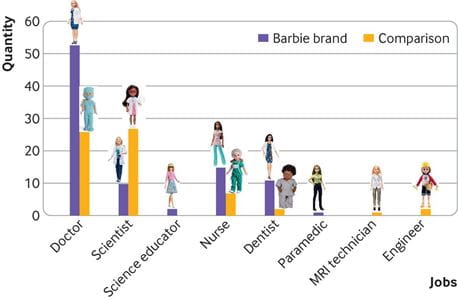It’s been 50 years since “Doctor Barbie” debuted; how realistic is the popular toy today?
Since Barbie’s creation in the 1950s, she’s gone through some drastic makeovers. The popular children’s toy created by Mattel boasts the slogan “you can be anything” and, in recent years, has added not only different body types and abilities, but also a variety of career choices and related accessories.But as a toy that models different professions for young girls, just how realistic is she when it comes to scientific and medical professions?
“Mattel has released at least 92 different medical professional and scientist Barbie dolls,” said Katherine Klamer, a grant writer for the radiation oncology division of the Indiana University School of Medicine. “These include medical doctors, nurses, paramedics and dentists as well as laboratory scientists.”
Klamer published a scholarly article Dec. 19 in The BMJ analyzing medical and scientific Barbie dolls to examine how accurately they are portrayed, especially when it comes to personal protective equipment (PPE) and other safety protocols, which she believes are important to properly portray for children playing with these kinds of dolls.
She looked at 92 total Barbie dolls—53 doctors, 10 scientists, 2 science educators, 15 nurses, 11 dentists and 1 paramedic. Of the 12 scientist Barbie dolls, none met all personal protective equipment requirements related to hair and clothing, such as wearing closed-toed shoes, full-length pants/skirts and not having loose hair or clothing in a laboratory setting. Klamer looked at another 65 dolls from a variety of other brands as a comparison and found most of those dolls did not wear proper personal protective equipment, either.
“One of the dolls I analyzed was a Chelsea doll, who is Barbie’s younger sister,” Klamer said. “She looks to be under age 10 but is working with an alcohol burner and glassware, and it doesn’t look like there is an adult there to help her. I just thought, ‘who would leave a kid alone with alcohol burners?’”
Klamer said realistic portrayals of medical and science professions matter, especially for girls. While science and medical professions are traditionally male-dominated fields, the number of women in these careers is growing. In the United States, women now comprise 37.1% of all practicing physicians; this number is expected to increase further, as women are beginning to make up the majority of medical school applicants in the U.S. Women also now account for more than half of all U.S. dental school students and earn more than half of all biological and medical research-related degrees.
As a double-major in chemistry and forensic & investigative sciences who completed multiple internships in labs at IU and Eli Lilly and Co., Klamer is passionate about promoting STEM careers among girls. As Mattel continues to improve diversity among their toys in a variety of ways, she hopes they’ll continue to improve how STEM careers are modeled as well.
“My biggest hope for Mattel, other toy companies or any media trying to represent scientists is that they would consult with scientists and professionals who work in the fields they’re trying to depict to avoid mistakes and be more accurate,” Klamer said. “All children’s movies and television shows in the United States are required to depict characters wearing bicycle helmets when bicycling or rollerblading, so why should these dolls be exempt from safety requirements? If they can model safety in one aspect, I don’t see what’s so bad about depicting it in another.”
The article didn’t just analyze safety; Klamer looked at how the dolls have changed over time and what medical specializations are depicted. In recent years, Mattel has created Barbies with more diverse medical conditions such as cancer, alopecia, Down syndrome and prosthetic limbs. But the majority of Barbies in health professions are general practitioners or pediatricians.
“Barbie is supposed to be an example for kids in different ways and encourage imagination,” Klamer said. “But how can those Barbies get specialized care if the only doctors around are general practitioners or pediatricians?”
Klamer does appreciate some of the changes Barbie has gone through in recent years, such as having flat feet, so she can wear sneakers in the lab rather than heels. She said she’d like to see Barbie continue to evolve.
“All toy companies should ensure that future medical professional and scientist dolls meet clinical and laboratory safety standards and diversify the types of medical and scientific professions represented (especially among male-dominated fields),” Klamer wrote in the article. “For young girls’ sakes as much as her own, Barbie must keep shattering glass ceilings.”
